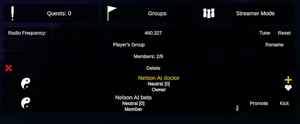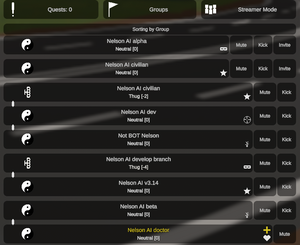Groups
Groups are a game mechanic crucial for co-operation in multiplayer games of Unturned (version 3). The in-game Groups menu is a tab available under the Information menu accessed using the M key.
The Players tab of the Information menu can be sorted by group, which lists groupmates next to each other and displays links (white lines) between them. Groups can be hidden in the list by disabling Group_Player_List.
By default, groups can be of any size, though this can be limited by the Max_Group_Members setting. Various other features of groups can also be modified using Gameplay config.
Usage
Creating groups
There are three ways of creating a group. Each can be disabled separately and restricting groups entirely consists in handling all of them separately: Allow_Static_Groups, Allow_Dynamic_Groups, Allow_Lobby_Groups.
In-game groups
Dynamic groups (also known as In-game groups) are created using the Create New Group button in the Groups menu. The button is only available if the player is not a member of any group.
Lobby groups
Static groups (also known as Lobby groups) are created whenever groupless players join a server using a Lobby. Players who are already part of a group on the given server, won't join the created group. Even if the players are part of a Unturned-assigned Steam group, the new group will be chosen on a newly-joined server.
Steam groups
Steam groups are based on groups created on the Steam platform. To assign an Unturned account with a Steam group, one needs to chose it within the Group section of the Survivors sub-menu of the Main Menu. Only groups the player's Steam account belongs to are available. After the assignment, the player will automatically join the group on any newly-visited servers. If a player leaves the Steam group in-game, it will be possible to rejoin it later using the in-game Group menu.
Managing groups
No matter the group type, the members can leave the group in-game by clicking the Leave button in the Groups menu. However usually, that action requires a delay before the player is actually removed from the group. After clicking the button, a chat message appears announcing to all groupmates that the player will abandon the group within the given time. By default, the delay lasts 30 seconds and can be adjusted with the Timer_Leave_Group setting. Groups can also be deleted by the owner which, unlike leaving, is always instant.
Non-Steam groups, are named after the group creator in the (player name)'s group format which can later be changed using the Rename button in the Groups menu.
Group can only have one Owner, but another rank, called Admin, is available after promoting the player in the Groups menu from the default Member rank. Group admins can invite and kick members of the group. A group admin can also be promoted one more time, passing the group ownership to them. Admins can also be demoted back to regular members. Only the group owner can manage ranks.
Players, who do not belong to any group, can be invited from the Players tab of the Information menu by either the Owner of a group, or any of its Admins.
Gameplay
Sharing location
Depending on configuration, other group members may be visible, as nicknames, on the player's HUD (the Group_HUD setting) if players are near enough and, as icons, on the Chart or GPS (the Group_Map setting). Map marker set by a player is visible to all their groupmates on a map or a compass. The marker color of each player can be edited in the Group section of the Survivors sub-menu of the Main Menu.
Structures and Locking
Structures and barricades placed by a player in a group can be removed or interacted with by any other member of their group. After leaving the group, the player regains unique access to their objects. Locked barricades (Jail Doors, Metal Doors, Vault Doors, Metal Gates and Metal Shutters), item storage (Metal Counters, Metal Counter Sinks, Lockers, Metal Plaques, Metal Rifle Racks, Metal Trophy Cases and Metal Wardrobes) and vehicles can be accessed by any groupmates of the player who placed/locked the object.
According to the Unturned Roadmap on Trello, a more realistic locking mechanism is under consideration, that would replace group-based storage sharing. The card does not mention doors, gates or vehicles though.
Combat
By default, groupmates cannot hurt each other. This can be overwritten by enabling the Friendly_Fire Gameplay setting.
If a player kills someone who attacked their groupmate they will gain Reputation instead of losing it similarly to what happens when a player kills someone in self-defense. Reputation points can also be gained by healing members of ones group.

